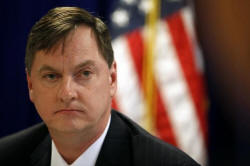|
"I
see benefits to trying to engineer policy to allow for the
strong possibility of inflation overshooting its target," Evans
said at an event in Sydney, Australia.
"I also think it would help to indicate that policymakers would
be willing to accept the increased inflationary risk that might
accompany further declines in unemployment," he added, citing
his view that the U.S. economy is not yet at full employment and
is in unprecedented territory compared to past cycles.
Speaking to reporters after the speech, Evans said he "could be
fine" with the Fed raising rates in December, but he wanted to
see how the economy and inflation progressed before deciding.
Indeed, he cautioned that it might be better to wait for
inflation to rise closer to the Fed's 2 percent target before
moving.
Evans has repeatedly expressed concern on the U.S. central
bank's preferred measure of inflation moving back to its target
rate. It currently stands at 1.7 percent.
Evans in his speech said any rise in inflation above the current
target would be minimal in the current environment so "if it
became necessary, policy wouldn't have to do much work to lower
inflation expectations back down to 2 percent."
The Chicago Fed president does not have a vote this year on Fed
policy but will become a voting member in 2017. Still, currently
he does participate fully in deliberations.
The U.S. central bank is still mulling another rate increase
almost a year after raising rates from near zero last December.
The Fed looks increasingly likely to raise interest rates this
December as long as job gains and inflation show further signs
of strengthening.
The Fed also meets in early November but traders do not expect a
move then given its proximity to the U.S. election.
Last Friday's monthly jobs report for September showed that
while employment growth is slowing, it is still well above the
level required to offset population growth. Fed Vice Chair
Stanley Fischer described the numbers as "close" to ideal.
Traders currently predict a roughly 70 percent probability that
the U.S. central bank will raise rates at its December meeting,
according to data from the CME Group.
(Reporting by Cecile lefort, Wayne Cole and Lindsay Dunsmuir;
Editing by Diane Craft & Shri Navaratnam)
[© 2016 Thomson Reuters. All rights
reserved.] Copyright 2016 Reuters. All rights reserved. This material may not be published,
broadcast, rewritten or redistributed.
 |
|





